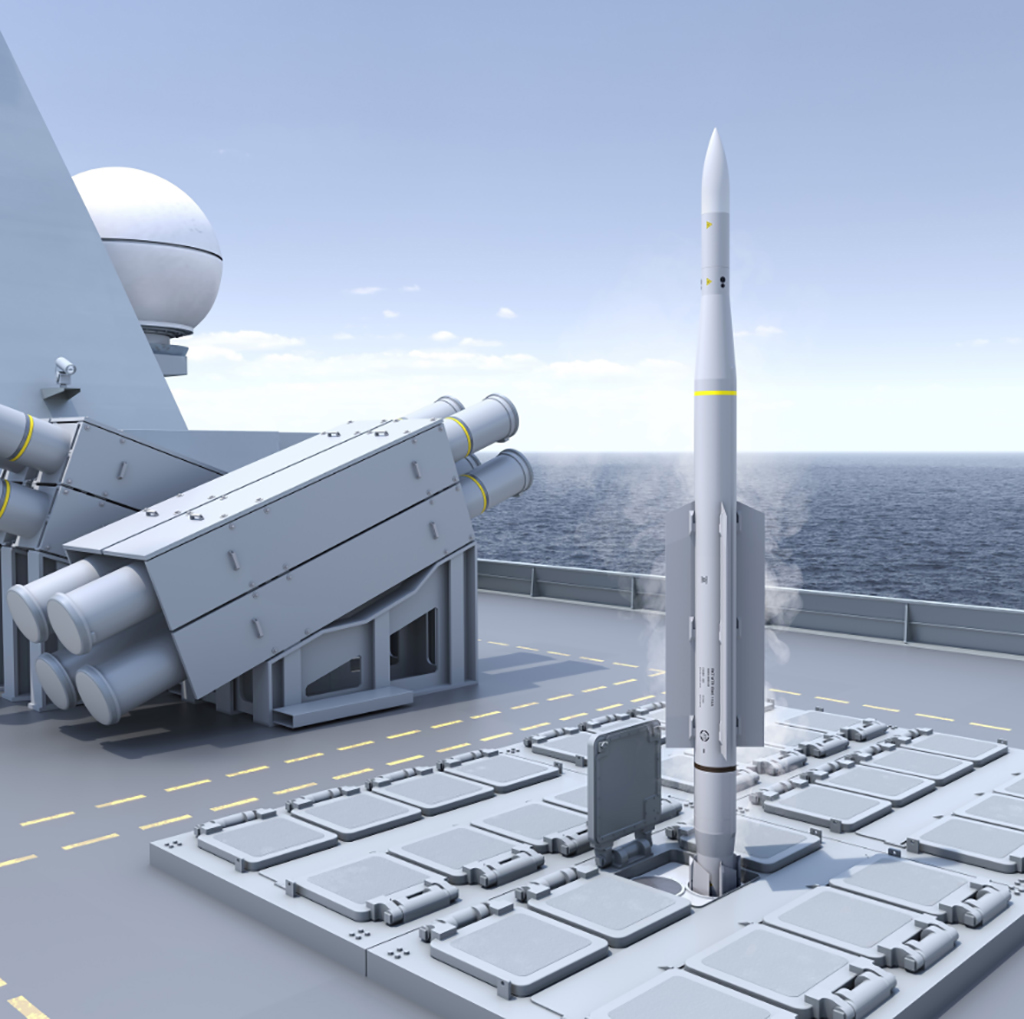
Poland’s President Andrzej Duda said that no expense should be spared in expanding the country’s defense capability, and promised that 4% of GDP would be spent on national defense in 2024.
Germany may have taken on the role of advocate for the strengthening of Europe’s ground-based air defense through its European Sky Shield Initiative, but it is next door in Poland where the real activity apparently is taking place.
Along with Warsaw’s already enormous investments in new main battle tanks, helicopters, and rocket and conventional artillery (AW&ST Sept. 4-17, p. 20), the Polish military is plowing billions of zlotys into a multilayer air defense umbrella—soon to be arguably one of the most comprehensive anywhere in the Western world.
- CAMM missile family will grow with UK-Polish medium-range work
- Procurement plans call for eight Patriot batteries
- Warsaw plans to spend 4% of GDP on defense in 2024
Spurred on by concerns about Russia’s extensive use of ballistic and cruise missiles in Ukraine, as well as thousands of Iranian-sourced one-way attack uncrewed aircraft systems, Poland is rapidly expanding the scale of its point, short- and medium-range ground-based air defense (GBAD) systems.
The scale of the plans became more apparent when Warsaw signed contracts worth $15 billion on air defense systems at the MSPO defense exhibition in Kielce on Sept. 5. The agreements included six batteries of RTX’s Patriot air-and-missile defense system—adding to the two previously purchased—as part of the second phase of the country’s Wisla (Vistula) medium-range air defense requirement.
Poland’s Patriots will not be the standard Foreign Military Sales fare—they include 12 examples of the 360-deg.-coverage Lower-Tier Air and Missile Defense Sensors, making the country the first export customer for the radar and reflecting concerns that threats could come from more than one direction.
The second phase of Wisla calls for continuing involvement in the Patriot program by Polish industry, including production and deliveries of M903 launchers and components for the PAC-3 missiles.
Warsaw also formally launched its Narew short-range program with the Polish Armaments Group (PGZ), under which it plans to purchase 22 Narew batteries equipped with European missile manufacturer MBDA’s Common Anti-Air Modular Missile-Extended Range (CAMM-ER). Poland is buying more than 1,000 of the missiles, most of which are to be produced in-country through a complex technology transfer mechanism that would have Polish industry building the components and assembling the complete missile. Once finalized in the coming weeks, the CAMM-ER purchase and technology transfer agreement would become MBDA’s largest-ever export commitment.
Both the Narew and Wisla agreements are in addition to the signing of a contract for the Pilica+ point defense system in April, which is planned to feature the standard CAMM missile, Poland’s Piorun man-portable surface-to-air missile and a locally developed autocannon.
Industry officials say Poland is in “1938 mode,” referring to when the country watched the growing threat from Nazi Germany.
Today it carefully watches its northern border with Russia’s Kaliningrad Oblast and to the east with Belarus, a nation essentially militarily subservient to Moscow. Poland has recently raised concerns about Belarusian provocations after Minsk flew helicopters across the frontier with Poland and provided sanctuary to Russia’s Wagner mercenaries.
“When we see the emerging danger beyond our eastern border, when we see the rebirth of imperialism, which we also faced in 1939 and for decades later . . . there is no price that is not worth paying for Poland to be free, sovereign, independent and for Poles to live safely,” Polish President Andrzej Duda said at MSPO’s opening ceremony. “State authorities very quickly [have] come to the conclusion that no savings can be made here [in defense] and all resources must be spent to defend themselves as effectively as possible.” He also admitted that Poland’s rearmament efforts had looked “chaotic at first,” but said that it was now delivering the intended effects (AW&ST Sept. 26-Oct. 9, 2022, p. 20).
To pay for all this new equipment, the country is raising its defense spending as a proportion of GDP to 4%, the highest rate in NATO, with plans to spend 137 billion zloty ($32 billion) in 2024, Duda said.

And this is far from the end of the air defense growth effort. Poland and the UK are advancing a joint effort to develop an even longer-range version of the CAMM to provide Warsaw with a lower-cost alternative to the Patriot PAC-3 Missile Segment Enhancement (MSE) missile that is equipping the Wisla batteries.
The so-called CAMM-MR (Medium-Range), also known as the Future Common Missile, is a proposed enlarged version of CAMM-ER but with a range of up to 80 km (50 mi.).
The initiative to develop a joint missile was born out of a joint agreement signed by the countries last October and is a component of a UK-Poland 2030 strategic partnership formed in July. The program is advancing into further studies through a letter of intent between MBDA and PGZ agreed to on the sidelines of MSPO.
MBDA has been contracted by the Polish defense ministry to study the nation’s requirement and propose several concepts that might satisfy it. One of the designs on display at MSPO showed a single-stage weapon with a broader and longer body than the CAMM-ER, to accommodate a larger rocket motor. One of the criteria is the ability to fit two of the missiles into a Mk. 41 Vertical Launching System that will equip Miecznik-class frigates.
The hope is that if fully developed, the CAMM-MR would share significant commonality with other members of the CAMM family, allowing Polish industry to produce the weapon in-country. However, the UK level of interest in such a weapon remains unclear. The UK is considering acquiring a medium-range capability but with the CAMM-ER, after underinvesting in ground-based air defense capability—like many European countries—for decades.
As well as the air defense systems, Poland signed contracts at MSPO for deliveries of additional coastal missile defense batteries from Norwegian defense firm Kongsberg. The land-based systems, which are planned to be used to protect Poland’s Baltic ports, use the Kongsberg Naval Strike Missile.
While far behind in quantities, Europe is waking up to the need for additional ground-based air defenses, with Slovakia the latest to join a growing list of European nations with plans to acquire an Israeli-developed GBAD to replace its Soviet-era systems.
